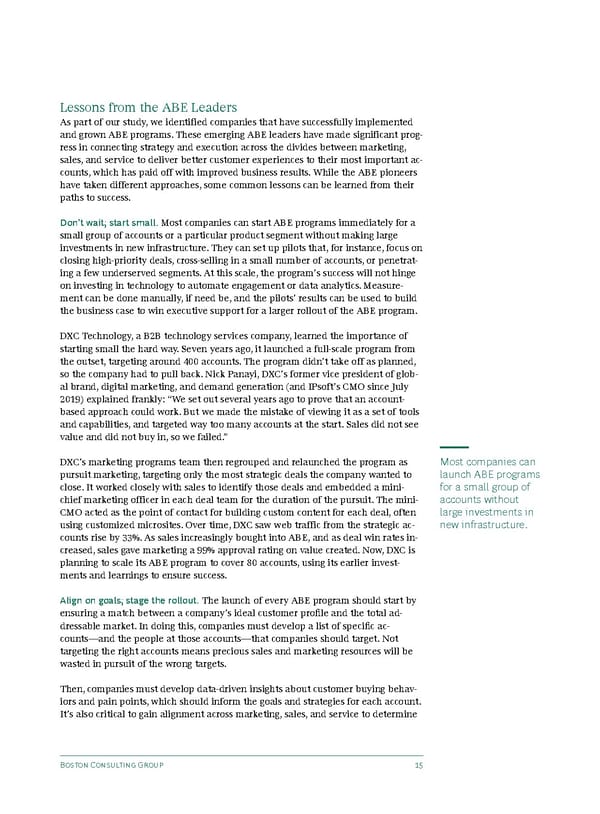Lessons from the ABE Leaders As part of our study, we identified companies that have successfully implemented and grown ABE programs. These emerging ABE leaders have made significant prog- ress in connecting strategy and execution across the divides between marketing, sales, and service to deliver better customer experiences to their most important ac- counts, which has paid off with improved business results. While the ABE pioneers have taken different approaches, some common lessons can be learned from their paths to success. Don’t wait; start small. Most companies can start ABE programs immediately for a small group of accounts or a particular product segment without making large investments in new infrastructure. They can set up pilots that, for instance, focus on closing high-priority deals, cross-selling in a small number of accounts, or penetrat- ing a few underserved segments. At this scale, the program’s success will not hinge on investing in technology to automate engagement or data analytics. Measure- ment can be done manually, if need be, and the pilots’ results can be used to build the business case to win executive support for a larger rollout of the ABE program. DXC Technology, a B2B technology services company, learned the importance of starting small the hard way. Seven years ago, it launched a full-scale program from the outset, targeting around 400 accounts. The program didn’t take off as planned, so the company had to pull back. Nick Panayi, DXC’s former vice president of glob- al brand, digital marketing, and demand generation (and IPsoft’s CMO since July 2019) explained frankly: “We set out several years ago to prove that an account- based approach could work. But we made the mistake of viewing it as a set of tools and capabilities, and targeted way too many accounts at the start. Sales did not see value and did not buy in, so we failed.” DXC’s marketing programs team then regrouped and relaunched the program as Most companies can pursuit marketing, targeting only the most strategic deals the company wanted to launch ABE programs close. It worked closely with sales to identify those deals and embedded a mini- for a small group of chief marketing officer in each deal team for the duration of the pursuit. The mini- accounts without CMO acted as the point of contact for building custom content for each deal, often large investments in using customized microsites. Over time, DXC saw web traffic from the strategic ac- new infrastructure. counts rise by 33%. As sales increasingly bought into ABE, and as deal win rates in- creased, sales gave marketing a 99% approval rating on value created. Now, DXC is planning to scale its ABE program to cover 80 accounts, using its earlier invest- ments and learnings to ensure success. Align on goals; stage the rollout. The launch of every ABE program should start by ensuring a match between a company’s ideal customer profile and the total ad- dressable market. In doing this, companies must develop a list of specific ac- counts—and the people at those accounts—that companies should target. Not targeting the right accounts means precious sales and marketing resources will be wasted in pursuit of the wrong targets. Then, companies must develop data-driven insights about customer buying behav- iors and pain points, which should inform the goals and strategies for each account. It’s also critical to gain alignment across marketing, sales, and service to determine Boston Consulting Group 15
 BCG moving beyond ABM to account based engagement Page 16 Page 18
BCG moving beyond ABM to account based engagement Page 16 Page 18